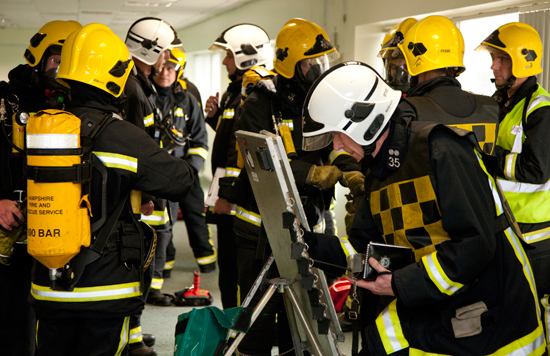feb2013MF
 This link will take you away from www.highrisefire.co.uk Please be aware that we do not necessarily endorse or support the views, opinions and expressions of this site !
This link will take you away from www.highrisefire.co.uk Please be aware that we do not necessarily endorse or support the views, opinions and expressions of this site !
|
|
|||
|---|---|---|---|
Incident Command : Who is actually in charge? |
|||
| HIGH-RISE Fire Fighting |
|||
| Developing better responses to fires in tower bocks and high-rise buildings. | |||

Photographs © Hampshire Fire and Rescue Service 2013
The concepts contained in the UK Manual of Firemanship : Incident Command, are well practiced and understood. There is specific reference to commanding High Rise incidents, but, it is restricted to only a few paragraphs and an illustration detailing a proposed command layout for a High rise incident.
The situation at the earliest stages of an incident in a high rise does not necessarily fall into the proposed ICS model and requires some analysis.
Skill set of the IC
There is also a degree of confusion as to the function of 'role' and 'qualification'. In many UK FRS there is an acknowledged qualification that enables operational personal to act as an incident commander. This qualification may be held by Firefighters. The level of this qualification usually relates to the 'scale' of the incident. Typically someone qualified at Supervisor 1 (Sup1) can command simple 1 or 2 pump incidents. Sup2 can command incidents with a life risk or up to 6 appliances, Sup3 commands incidents up to 12 appliances and so on.
This process fails when there is a restricted availability of personal with the suitable level of qualification. This can lead to situations where a Sup1 attends a rapidly developing incident with a life risk and requests further resources. These resources may arrive and need deployment long before a commander with the required qualification to manage them arrives. This situation is not unique to High Rise.
Any personnel given the responsibility of acting as IC at any stage of a High Rise incident must have a core skill set that includes an understanding of the unique risks that any given High Rise building poses. Without this the IC can not make safe or satisfactory risk assessments and can not balance any risk against benefit (as they are not risk aware).
It is the authors firmly held belief (and has been for many years) that command at HR incidents should be a specific, trained for, audited skill. ( see :Training )
First attending appliance.
Conveniently the Officer-in-charge of the first attending appliance will be the initial Incident commander. With an attendance of only a single appliance, status quo will apply, but as further appliances attend, the function of IC may be passed on.
This typically happens at a high rise incident when the first attending appliance OIC deploys to the Incident floor/bridgehead, before additional attendances arrive. At this time he/she will be overall IC, but is in the unusual situation of being inside the building. This is somewhat at odds with the current doctrine of the IC staying outside (or remote) from the incident.
The EVOLVING Command structure.
The command structure at a high rise incident must naturally evolve as the incident escalates
feb2013MF
 This link will take you away from www.highrisefire.co.uk Please be aware that we do not necessarily endorse or support the views, opinions and expressions of this site !
This link will take you away from www.highrisefire.co.uk Please be aware that we do not necessarily endorse or support the views, opinions and expressions of this site !